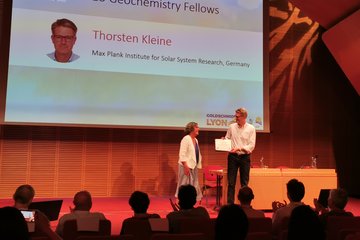Alle Typen
21.
Zeitschriftenartikel
ULYSSES observations of energetic H3+ ions in Jupiter's magnetosphere. Advances in Space Research 20, S. (2)229 - (2)232 (1997)
22.
Zeitschriftenartikel
Numerical simulations of non-adiabatic particle motions in the Jovian magnetosphere; comparisons with ULYSSES observations. Planetary and Space Science 44, S. 153 - 161 (1996)
23.
Zeitschriftenartikel
The high latitude pass of ULYSSES: energetic particle observations with EPAC. Astronomy and Astrophysics 316, S. 464 - 480 (1996)
24.
Zeitschriftenartikel
Observations of energetic particles with EPAC on Ulysses in polar latitudes of the heliosphere. Il Nuovo Cimento 19C, S. 915 - 920 (1996)
25.
Zeitschriftenartikel
The charge state of helium in the Jovian magnetosphere: a possible method to determine it. Planetary and Space Science 44, S. 71 - 75 (1996)
26.
Zeitschriftenartikel
ULYSSES observations of energetic particle acceleration and the superposed CME and CIR events of November 1992. Annales Geophysicae 14 (4), S. 400 - 410 (1996)
27.
Zeitschriftenartikel
A ULYSSES cosmic ray latitude gradient observation and modulation models. Solar Physics 163, S. 397 - 403 (1996)
28.
Zeitschriftenartikel
Coronal diffusion and high solar latitude recurrent energetic particle increases. Astronomy and Astrophysics 316, S. 506 - 510 (1996)
29.
Zeitschriftenartikel
Recurrent variations of anomalous oxygen in association with a corotating interaction region. Annales Geophysicae 14 (6), S. 585 - 588 (1996)
30.
Zeitschriftenartikel
On the minimum fluxes of low-energy ions (0.5 MeV/nuc-8 MeV/nuc) at high heliospheric latitudes. Advances in Space Research 15, S. (7)81 - (7)84 (1995)
31.
Zeitschriftenartikel
The elemental composition in energetic particle events at high heliospheric latitudes. Space Science Reviews 72, S. 339 - 342 (1995)
32.
Zeitschriftenartikel
Energetic particle observations at high heliographic latitudes. Space Science Reviews 72, S. 285 - 289 (1995)
33.
Zeitschriftenartikel
Observations of energetic particles with EPAC on Ulysses in polar latitudes of the heliosphere. Science 268, S. 1013 - 1016 (1995)
34.
Zeitschriftenartikel
Energetic particle observations in high heliographic latitudes. Nuclear Physics B (Proc. Suppl.) 39A, S. 87 - 93 (1995)
35.
Zeitschriftenartikel
Ion measurements in the Jovian magnetosphere by the Ulysses EPAC experiment: A comparison between dawn and dusk sectors. Advances in Space Research 16, S. (4)183 - (4)186 (1995)
36.
Zeitschriftenartikel
Ulysses-Voyager study of energetic particles associated with the intense solar activity of March/June 1991. Space Science Reviews 72, S. 359 - 364 (1995)
37.
Zeitschriftenartikel
Cosmic ray modulation by expanding, high-latitude streams. Geophysical Research Letters 22, S. 3345 - 3348 (1995)
38.
Zeitschriftenartikel
A particle event at 5 AU and 20o southern latitude from measurements with the EPAC instrument on Ulysses. Space Science Reviews 72, S. 343 - 346 (1995)
39.
Zeitschriftenartikel
Über die Wichtigkeit, Menschen zum Mars zu schicken. Z. Flugwiss. Weltraumforsch. 18, S. 155 - 159 (1994)
40.
Zeitschriftenartikel
Signature of the Martian moon Phobos in the fluxes of energetic particles as measured by experiment SLED onboard Phobos 2. Space Science Reviews 4 (6), S. 435 - 440 (1993)











